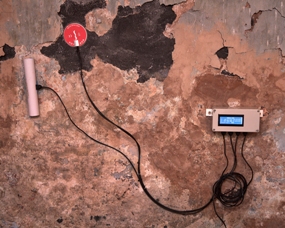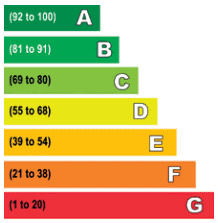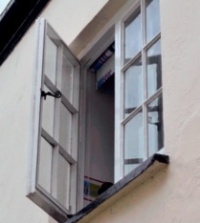Sustainability Standards and Regulations
John Edwards
 |
||
| A miner's cottage in David Street, Cwmdare: analysis of the building's pathology as required under BS 7913: 2013 provided information on the effects of damp on the in situ U-value, and demonstrated that the walls were more thermally efficient than predicted. (Photos: John Edwards) |
The mention of the energy efficiency of buildings almost always brings up U-values, energy performance certificates, standard assessment procedures (SAP and RdSAP) and building regulations. Those who are a little more informed may also refer to terms like BREEAM, Passivhaus, BREDEM and possibly even EnerPhit. These are all to do with prescribed ways of dealing with energy efficiency of buildings and sometimes their wider sustainability. All have their place but will not necessarily be appropriate and reliable, particularly where historic or traditionally constructed buildings are concerned. However, they are often the means by which we have to assess such issues.
Many of the acronyms stand for things we don’t necessarily have to adopt, but we do have to be mindful of them because of the potential benefits as well as the potential risks in adopting such schemes and processes.
One regulatory framework that applies to almost all development is the Building Regulations, and the part concerning the conservation of fuel and power is particularly important. Although there is some variation between those adopted by each of the UK home nations, all versions require what we call ‘consequential improvements’ when works to the thermal envelope are undertaken.
THE BUILDING REGULATIONS
In England and Wales, the Building Regulations are worded more emphatically than in Scotland and Northern Ireland. While there is an expectation that reasonable efforts will be made to improve energy efficiency, listed buildings, scheduled monuments and buildings in conservation areas do enjoy some degree of exemption depending on which UK home nation they are in. However, over 90 per cent of traditional buildings don’t come under these categories even though from a technical perspective, most of the buildings are just the same as those which receive statutory protection.
 |
In England and Wales ‘special consideration’ can be given to buildings which have vapour permeable construction when the regulations would otherwise require work which may impede the movement of moisture. In Northern Ireland and Scotland it is less emphatic but, as in England and Wales, work must be ‘technically feasible’ and this is where the imposition of such works can be challenged. Here, British Standard 7913 can be used to support the case for not undertaking works which would adversely affect the building’s performance.
BS 7913: 2013 Guide to the Conservation of Historic Buildings (to give the standard its full name) emphasises that damp building fabric could be over a third less thermally efficient than dry building fabric, thus highlighting the importance of appropriate repair and maintenance measures as described in the document. In this respect, building maintenance is an energy conservation measure that should always come before the ‘improvements’ arising out of the Building Regulations, RdSAP and such like.
One very important issue that BS 7913 raises is the need for proper condition surveys based on an understanding of the pathology of historic buildings and the materials used: this is especially essential when considering the impact of problems such as damp. Another important issue is the need to consider significance and the undertaking of heritage impact assessments. All traditional buildings have some significance and the impact of measures on that significance always needs to be understood.
THE STANDARD ASSESSMENT PROCEDURE – RDSAP and SAP
The most common detrimental tool imposed on domestic traditional buildings is RdSAP – the reduced data standard assessment procedure – which was the basis for advice provided under the UK government’s failed financial incentive scheme, the Green Deal. Today its most common use is in producing energy performance certificates (EPCs) when a dwelling is being let or sold, unless it is listed.
 |
||
| Proposals are sometimes put forward for external wall insulation to be applied intermittently to the front elevation of individual houses in a terrace, despite there being features of architectural interest. A heritage impact assessment may prevent alterations like this from happening. Aesthetics are not the only consideration under the significance umbrella, but assessing significance will inevitably mean a greater likelihood of external wall insulation being applied to plain rendered elevations than to very ornate elevations with bay windows. This terrace is somewhere between the two, which is where the more difficult decisions lie. (Photo: Historic Environment Scotland) |
RdSAP will almost always underestimate the current energy efficiency of a traditional building and therefore make recommendations for works which are not necessary and which may not make a building more energy efficient. There are a number of reasons why this is the case, but the main one concerns the standardisation of U-values which normally results in the thermal performance of traditional construction being underestimated. It becomes a serious concern when this results in inappropriate measures being deployed.
Despite these well-known flaws, the imposition of RdSAP is being taken a stage further. The Private Rented Sector Energy Efficiency Regulations (Domestic) dictate that by April 2018 residential properties cannot be let unless they reach energy performance rating band E. Property owners may have to undertake works which deliver SAP points determined by RdSAP. There is no reward, however, for maintaining buildings properly and appropriately and keeping building fabric dry, all of which help to make buildings far more energy efficient and sustainable.
BREEAM and BREDEM
The Building Research Establishment’s environmental assessment method (BREEAM) for the refurbishment of domestic buildings contains some very good practice in considering a range of issues, but where energy is concerned it is flawed in using RdSAP for the reasons stated above. Another version of BREEAM has been developed for the refurbishment of non-domestic buildings where research by BRE has established that heritage buildings do relatively well. However, while RdSAP is not part of this process, the full version of SAP is, and again the standardisation of performance data (such as the U-values of existing walls) results in inevitable inaccuracy where energy performance is concerned.
The BREDEM (BRE Domestic Energy Model) is also based on SAP, hence its potential unreliability in some areas, but it could nevertheless provide some good advice. Again, caution is needed and it would be sensible to refer to BS 7913: 2013 in order to reduce risks and take a more robust approach.
PASSIVHAUS and ENERPHIT
Passivhaus is defined as: ‘… a building for which thermal comfort can be achieved solely by post-heating or post-cooling of the fresh air mass, which is required to achieve sufficient indoor air quality conditions – without the need for additional recirculation of air’. A version has also been developed for retrofit and refurbishment called EnerPHit which has less challenging heat demand and airtightness requirements. There are many aspects of EnerPhit which are very good such as mechanical heat recovery, but the approach still relies on high levels of insulation and airtightness and will only work well if the relevant products have been installed properly.
Although traditional buildings need to retain their vapour permeability characteristics, the high insulation levels which are required (to achieve the specified U-values) inevitably means solid wall insulation. The technical feasibility of installing solid wall insulation will depend on the construction of the building and its location, with due consideration paid to UK weather exposure zones. This might not be feasible in BRE zones three and four (which includes most of Scotland, Wales and Northern Ireland, and the more westerly areas of England). The impact on significance that such works would make also needs to be assessed.
HOLISTIC ALTERNATIVES
While all these official and credible energy and environmental assessment methods provide tangible outputs, they are all unreliable or potentially problematic when it comes to traditional buildings. The best way of achieving energy efficiency in a sustainable way is to take a holistic approach which considers all aspects of the building. This, however, doesn’t deliver any SAP points which are of course needed for EPCs to improve the official energy performance rating.
The STBA retrofit guidance wheel is an excellent tool for going through the process of choosing retrofit measures and there isn’t anything better that does this. It takes one through all the options, steering away from those measures which are most risky and less likely to work, and towards those which are less risky and more likely to work. It also advises on how measures interact and therefore what they mean in combination with each other. But again, the wheel needs to be used with caution. It is essential to understand the makeup of the building and its condition, and there is no substitute for a thorough building survey which addresses the cause of problems from a building pathology perspective. In addition a heritage impact assessment may well be required to measure the impact of proposals on the historic significance of a building.
 |
 |
 |
| Above left: an EPC gives a property an energy efficiency rating from A (most efficient) to G (least efficient). Figures on the left give the SAP points required for each rating band. Above centre: simple secondary glazing fitted to a casement window. Above right: draught-stripping sash windows at Clovelly, Devon as part of the programme of EPC improvement measures. (Both photos: Jonathan Taylor) | ||
There is much concern from the well-informed about the approach we take towards the energy efficiency and sustainability of traditional buildings. One problem is that standards and guidance suitable for modern construction systems are often incorrectly applied to traditional structures, and there is clearly a lack of specialist expertise in this area. However, other forms of retrofit have had even greater detrimental impact on traditional buildings. For example, the retrofitting of damp-proof courses and the associated works (such as the use of impervious plasters and cement renders, and often the replacement of rotten timber floors with concrete) have, just like many forms of energy efficiency retrofit, resulted in changing the hygrothermal performance of traditional buildings. Dampness and mould are common symptoms and both suggest that any form of retrofit needs to be well informed.
Several new courses are beginning to address these problems. In particular the new Level 3 SQA Award in the ‘energy efficiency and retrofit of traditional buildings’ had trained 200 people by the end of 2016. However, there are some six million traditional buildings in the UK, and with an acknowledged deficiency in the knowledge and skills of both the professions and building contractors in this area, thousands need to be trained not hundreds.



